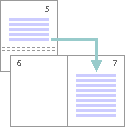The following examples show the types of section breaks you can insert. (In each illustration, the double dotted line represents a section break.)
Next page inserts a section break and starts the new section on the next page.

Continuous inserts a section break and starts the new section on the same page.

Odd page or Even page inserts a section break and starts the new section on the next odd-numbered or even-numbered page.

 Types of formats you can set for sections
Types of formats you can set for sections
You can change the following section formats:
-
Margins
-
Paper size or orientation
-
Paper source for a printer
-
Page borders
-
Vertical alignment
-
Columns
-
Page numbering
-
Line numbering
-
Footnotes and endnotes
Keep in mind that a section break controls the section formatting of the text that precedes it. For example, if you delete a section break, the preceding text becomes part of the following section and assumes its section formatting. Note that the last paragraph mark in the document controls the section formatting of the last section in the document